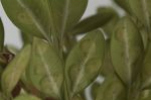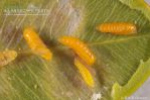HOST PLANTS:
Boxwood Buxus spp.
DAMAGE:
Female flies puncture foliage creating a small yellow hole on the underside of leaves to lay eggs. Larvae mine leaves by feeding on the mesophyll layer, forming a blister on the surface of foliage and often discoloration. The blisters are often yellow in the centre and have a translucent emergence hole created by mature larvae. There can be multiple larvae in each blister.
DESCRIPTION AND LIFECYCLE:
Adults are small delicate orange coloured midges with fringed wings. Males have three distinct brown spots on the thorax. Females have a spine-like ovipositor (structure at the end of her abdomen used for laying eggs).
Larvae are yellow to orange legless maggots and are approximately 1.5 mm.
Eggs are small (0.21 mm), translucent and cylindrical, tapering at both ends. Females deposit eggs inside the mesophyll of new leaves using her spine-like ovipositor.
Larvae are active in early spring. Before pupating they create a translucent window by thinning out an area of the leaf. Pupation occurs inside the blister and adults emerge 14-15 days later. Adults mate and lay eggs in late spring. Females lay on average 29 eggs, each in embedded inside the mesophyll layer of leaves. Eggs hatch and larvae begin to feed creating the blister in the process. Larvae will remain inside the blister until the next spring, overwinter as a mature 3rd instar larva. There is one generation per year.
CONTROL MEASURES:
Choose some of the more resistant species. Pruning the foliage before adult emergence or after egg laying ends will reduce the overall population. Apply approved insecticides when the mines first appear, when weigela is in bloom, to reduce populations.




reference; woodypests.cas.psu.edu, Penn State Extension Program Assistant
